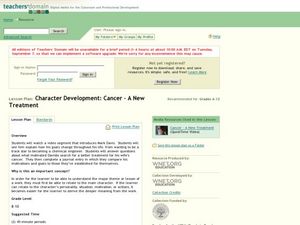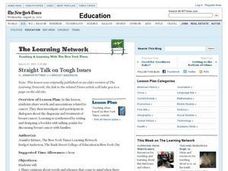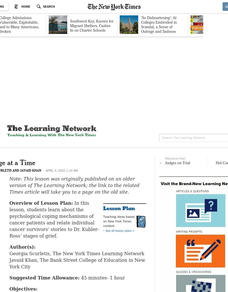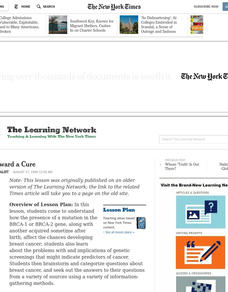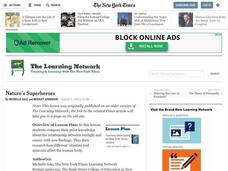Curated OER
Tobacco Smoking and Lung Cancer
Students explore tobacco smoking and the impact it has on society. In this health lesson students complete several experiments on smoking and lung cancer.
Curated OER
The Tobacco Time Bomb: What's In A Cigarette?
For this enlightening and disturbing health lesson, young scholars read and discuss information on smoking and closely-look at the ingredients in a cigarette. You will be amazed at the list of ingredients that are found in cigarettes....
Curated OER
Cancer
Students study cancer and possible preventative measures. In this cancer lesson students study the claims on food labels and ways to lower your risk of cancer.
Curated OER
Cancer Research
Students participate in a class demonstration to see how many Americans are affected by cancer in their lifetime. In this public health lesson, students are placed in situations that allow them to experience how relevant cancer...
Curated OER
Breaking News English: Cancer
For this cancer worksheet, students read the article, answer true and false questions, complete synonym matching, complete phrase matching, complete a gap fill, answer short answer questions, answer discussion questions, write, and more...
Curated OER
Character Development: Cancer - A New Treatment
Students explore the concept of character development. For this character development lesson, students watch a video segment regarding a family's struggle with cancer. Students examine the personality, situation,...
Curated OER
Control of the Cell Cycle
In this cell cycle learning exercise, students review how enzymes control the cell cycle and what happens when the cell cycle becomes uncontrolled. This learning exercise has 7 short answer questions.
Curated OER
Straight Talk On Tough Issues
Students engage in a lesson that is focused upon the concept of breast cancer and research is conducted using a variety of reference sources. They reflect upon how different people deal with the tragedy of cancer and then students write...
Curated OER
UV Rays, sunscreen effectiveness
Students identify and define that invisible UV rays can be harmful. Then they explore the effects of UV radiation on objects that react UV rays and what products are most effective in blocking UV rays. Students also make predictions...
Curated OER
Innovations in Elder Care
Students describe the symptoms and suspected causes of Alzheimer's disease or cancer. They describe current research projects seeking to learn more about or find treatments for either Alzheimer's disease or cancer. Students compare...
Curated OER
Protect the Skin You're in
Students explore the importance of sun safety in relationship to skin cancer prevention. They test the effectiveness of various sunscreens and administer and analyze a simple survey to their peers. In addition, they implement a public...
Curated OER
UV: Use Caution
Students investigate the concept of skin cancer and its relation to using tanning beds that expose people to artificial ultraviolet rays. They research the effects and look for ways to prevent the onset of skin cancer from the...
Curated OER
The Genetic Diagnosis of Cancer: The Questions Continue to Multiply
Students review the basic concepts of genetics, such as Mendelian inheritance and pedigree construction and analysis. They use an activity that uses recent findings in cancer genetics to present. Students use a pedigree in a "real...
Curated OER
Could There Be Cancer in My Classroom? Part II
Middle schoolers collect and record data from a variety of web sites concerning cancer and treatment options. They examine a specific case study of a girl with cancer and determine what her treatment options might be.
Curated OER
Animal Organs and the Study of Reproduction, Embryology and Cancer
Students examine organs from dogs and cats to study reproduction, embryology, and the identification of cancer. They record their observations at both the gross and microscopic levels. They present their information to the class.
Curated OER
Risk Factor Roulette
Students examine "multiple chemical sensitivity" and how it relates to genetic variation and environmental factors. They read an article, conduct research, and identify risk factors related to chemical sensitivity, asthma, breast cancer,...
Curated OER
Cancer Causes
Students explore why people get cancer. They explore human cells by taking a close examine their own. take a small sample of the epithelial cells that line the inside of their mouth. They glimpse how scientists investigate inside cells.
Curated OER
One Stage at a Time
Students explore the psychological coping mechanisms of cancer patients and relate individual cancer survivors' stories to Dr. Kubler-Ross' stages of grief. They use first-person accounts, discussion and journals to explore these concepts.
Curated OER
Race Toward a Cure
Students come to explain how the presence of a mutation in the BRCA-1 or BRCA-2 gene, along with another acquired sometime after birth, affect the chances developing breast cancer.
Curated OER
Nature's Superheroes
Students compare their prior knowledge about the relationship between sunlight and cancer with new findings. They research how different vitamins and minerals affect the human body.
Curated OER
Skin Cancer Prevention
Students discuss skin cancer prevention. In this skin cancer lesson, students read a pamphlet that tells the causes of skin cancer and what you can do to prevent it. Students will choose from a variety of projects which focus on skin...
Curated OER
Phytochemicals
Students study what phytochemicals are, how they work and where you can find them. In this food chemicals lesson students complete and activity and study products that contain phytochemicals.
Curated OER
The Benthic Drugstore
Students examine active chemicals that are in marine invertebrates and how they act to fight diseases. In this marine lesson students identify three pharmacologically-active chemicals, describe their disease fighting action and...
Curated OER
Intermediate sentence completion: 33
In this sentence completion instructional activity, students fill in the blanks with the appropriate words to complete each sentence. Students complete 10 multiple choice questions.







